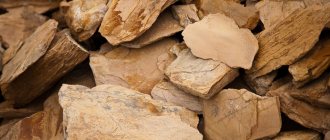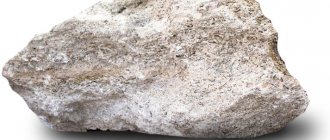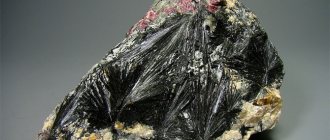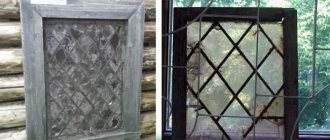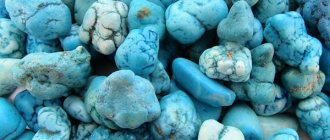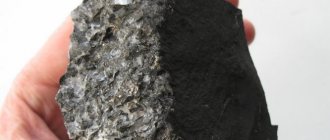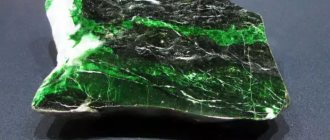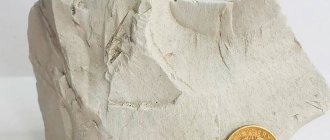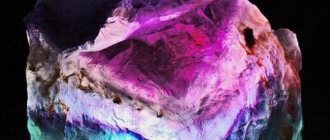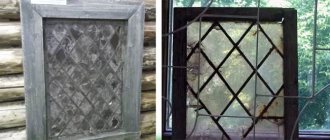When treating fractures in medicine, plaster casts are used to immobilize the limb, which is necessary for proper bone healing. The plaster cast is made from calcium sulfate, which is a white powder that is mixed with water and hardens very quickly, thereby ensuring reliable fixation of the limb.
Applying a plaster cast is a very responsible process, so this procedure should only be performed by a doctor, since an incorrectly applied plaster cast can cause serious harm to health and aggravate the injury.
What is gypsum
For most people, plaster is a hard, opaque grayish substance that is placed on a broken arm or leg in the hospital.
However, the description of the natural mineral is richer:
- It can be half or completely transparent, translucent, even luminous.
- Gloss – pearlescent, glassy, silky, matte.
- More often it is presented as a tabular agglomerate or crystals - columns, prisms, needles.
The mineral cannot be dissolved by most acids, but water has no problem.
This characteristic of gypsum is unique: solubility with water is maximum at 37.8°, after which it tends to zero.
Characteristics and properties of gypsum
Calcium sulfate dihydrate, or simply gypsum, is a natural mineral, a calcium salt of sulfuric acid or calcium sulfate, which naturally forms deposits of alabaster and selenite. It is these that are mined and then ground into powder, producing gypsum dihydrate.
Appearance of plaster
Even 3000 years ago, people learned to use gypsum in decorating their homes. Today, about 70 million tons of this material are mined annually. It is used not only in construction, but also in agricultural and other industries.
The characteristics of gypsum are truly unique:
- it is not allergic, non-toxic, completely safe;
- it does not react to high temperatures and is fireproof;
- is light in weight;
- hygroscopic;
- affordable.
Thus, using gypsum when decorating a room, you get many benefits. Of course, the most important advantage is that you will be confident that the materials around you are hypoallergenic and that release certain substances into the air. Since the material is completely natural, formed from rocks, it does not cause any health problems.
Gypsum is also a hygroscopic material and absorbs excess moisture, releasing it back when the air is dry. This is its slight drawback - it cannot be used for street decoration of buildings. Also, at home you should not place it in the bathroom or near places in contact with moisture. However, the water it accumulates can serve on dry summer days - gypsum also gives it away easily. If you plan to decorate wet rooms, then it is better to take concrete. For other types of interior work, gypsum is, of course, the best option, since concrete is much heavier and more expensive.
Which plaster to choose from those offered on the market depends on the type of repair work. The strength of gypsum is adjusted on a scale from 2 to 25 units; for tiles, it is recommended to buy gypsum with a density of hardened material of more than 10 units. The marking also indicates the hardening speed A - up to 6 minutes, B - from 6 to 20 minutes and C - more than 20 minutes. Of course, when making stones, it is better not to use a quickly hardening brand, especially for beginners. If you practice pouring stones for up to 5 minutes, you can experiment with quick-hardening compounds. Another significant indicator indicated on the packaging is the grind size, where I is coarse grinding, II is medium grinding, III is fine grinding.
The finer the gypsum grinding indicated on the marking, the stronger the mixture, but it is also more difficult to work with this mixture when mixing. To increase strength and other properties, gypsum is mixed with fine sand and slaked lime.
Physico-chemical characteristics
According to chemical nomenclature, the mineral gypsum is aqueous calcium sulfate. The international classification defines the mineral class as sulfates.
Its composition is complex, the formula is multi-component.
| Formula | CaSO4 2H2O |
| Color | White, shades of gray and red |
| Stroke color | White |
| Shine | Glass to pearlescent |
| Hardness | 1,5—2,0 |
| Cleavage | Very perfect |
| Kink | Uneven; flexible but not elastic |
| Density | 2.2—2.4 g/cm³ |
| singonia | Monoclinic |
| Refractive index | 1,52 |
Genesis of the mineral and its distribution in nature
Gypsum is a typical mineral of sedimentary origin. Most often it is formed from natural aqueous solutions (for example, at the bottom of drying seas and reservoirs). The mineral gypsum can also accumulate in weathering zones of native sulfur and sulfides. In this case, so-called gypsum hats are formed - loose or compacted rock masses contaminated with numerous impurities.
In sedimentary rocks, gypsum is often found accompanied by sand, rock salt, anhydrite, sulfur, limestone and iron. The proximity to the latter, as a rule, gives it a brownish tint.
In nature, gypsum occurs in the form of elongated and prismatic crystals. It also often forms dense scaly, fibrous, or “tablet-like” aggregates. Often gypsum is presented in the form of so-called roses or swallowtails.
Place of Birth
Sedimentary origin ensured the widespread occurrence of the rock on the planet:
- Russian deposits are concentrated in the North Caucasus, in the vicinity of the Urals, Krasnodar Territory, Tatarstan, and Dagestan.
- The largest suppliers of raw materials to the world market are the USA, Canada, Spain, Iran, and Turkey.
Some mines are unique. For example, in Oklahoma. This US state has an array of natural gypsum formations - the Alabaster Caves park with raw materials of white, pink and rare black color. However, they extract it there in crumbs.
Origin
If we talk about the origin of this mineral in nature, we can trace its close connection with anhydride. Also, its formation occurs during the hydration of anhydrite. Sometimes during the formation of gypsum, loose and loose masses appear.
Place of Birth
Gypsum deposits are found in the Western Urals, Dagestan, North Caucasus, Italy, USA, France, Central Asia, Canada and Russia. Pink alabaster can be mined in Wales.
Varieties of mineral
Depending on the structure, density, and other characteristics, several types of gypsum are distinguished:
- Alabaster. The whitest mineral of high purity. Among the Greeks, the term αλαβαστρος meant “white.” Formed when gypsum is heated to 142°C.
- Selenite. A colorless variety of fibrous structure with a silky sheen. Found a century and a half ago in the Urals. Named due to the radiance that seems to emanate from within the stone. Based on this characteristic, it can be easily distinguished from other types of gypsum.
In Russia it is known as “Maryino glass”. The history of the name is connected with the tradition of covering the faces of saints, especially the Mother of God (Virgin Mary), with transparent selenite plates.
- Desert Rose. Plaster plates of pastel shades, assembled in the shape of a rosebud. Found in the deserts of Africa.
- Crystal. Not a particularly durable mineral with grayish tints. Goes for souvenirs.
- Anhydride. Dehydrated gypsum in the form of crystals (sometimes very large). Looks like marble. It is easy to distinguish the origin by placing the sample in a humid microclimate. The plaster will gradually swell and become deformed.
Mineral Anhydride
There is a classification of the mineral according to the speed of setting (fast-, medium-, slow-hardening gypsum).
Practical use
The practical importance of gypsum is great, especially in construction.
- Model or molded (half-burnt) gypsum is used to produce castings, plaster casts, molded decorations of cornices, plastering ceilings and walls, in surgery, paper production for the production of dense white grades of paper, etc. In the construction industry, it is used as cement for brick and stone masonry , for printed floors, making bricks, slabs for window sills, stairs, etc.
- Raw (natural) gypsum is used mainly in the cement industry as an additive to Portland cement, a stone material for sculpting statues, various crafts (especially Ural selenite), in the production of paints, enamels, glazes, in the metallurgical processing of oxidized nickel ores, etc.
It is used in the production of binding construction minerals (construction gypsum, alabaster - semi-burnt gypsum, cement), in medicine, the paper industry, and as a fertilizer. Selenite is used as an inexpensive ornamental stone.
Where is it used?
The scope of application of gypsum is limitless. Each uses the right type of raw material.
Application areas
This is an inexpensive, practical material for cement, slabs, blocks, cornices. Suitable for interior or exterior.
Alabaster is important as a raw material in the production of special grades of paper, enamels, paints, glazes, and medical compositions.
The substandard material is ground and turned into a soil desalinizer.
Aesthetics
Sculptors cannot work without plaster blanks.
Master stone carvers turn stone into small plastic pieces, vases, and boxes.
Colorless transparent selenites are especially in demand. Stone cutters transform mysteriously shimmering pebbles into small plastic pieces, an esoteric assortment: pyramids, balls, pendulums.
Selenite bracelet
Jewelers create cabochons.
However, the fragility of the mineral limits the range. These are mainly pendants, pendants, brooches - things that do not risk quickly wearing out or crumbling.
Collecting
You can collect the “gypsum section” of a mineralogical collection for years, the manifestations and forms of the mineral are so diverse.
Connoisseurs are especially interested in “desert rose”, “Maryino glass”, black and pink stones from America, “dovetail”, samples with the cat’s eye effect.
Maryino glass
Gypsum as a building material
The building material gypsum is obtained from gypsum stone. To do this, the rock is fired in special furnaces and then ground into a fine powder. Subsequently, the resulting raw materials are widely used in construction and finishing.
The industrial industry has its own classification of gypsum - technical. So, the following varieties are distinguished:
- high-strength gypsum (used in medicine and dentistry; various building mixtures and molds for the porcelain and earthenware industry are also produced from it);
- polymer (used exclusively in traumatology for applying fixing bandages for fractures);
- sculptural (the name speaks for itself - this is the main component of putty mixtures, various figurines and souvenirs);
- acrylic (lightweight gypsum used for finishing building facades);
- fireproof (non-flammable material, from which plasterboard sheets and wall blocks are often produced).
In addition, there is a separate marking of gypsum for strength. According to it, 12 grades of gypsum are distinguished - from G2 to G25.
Alabaster is also widely used in construction and finishing works. Compared to gypsum, it is stronger and easier to process. True, without special additives, alabaster is practically unsuitable, since it dries instantly.
It is important to note that even with the current, high level of development of science and industry, a worthy replacement for gypsum has not yet been found.
How to care
Plaster is strong, but vulnerable, so you need to care for it carefully:
- Avoid falls, impacts, and mechanical impact.
- Protect stones from the harsh sun (especially alabaster, which quickly turns yellow and fades).
- Do not place products in rooms with consistently high humidity (bathtub, swimming pool, open veranda, greenhouse).
A humid microclimate is detrimental to gypsum: the mineral becomes saturated with water, losing its shape and decorativeness.
Contaminants are removed from the stone with a dry or slightly damp cloth.
It is useful to recharge the selenite variety of the mineral with the light of the Moon by placing it on the windowsill at night.
How to make high-quality decorative (artificial) stone from gypsum with your own hands
Now it is becoming popular to make decorative stone with your own hands for interior wall decoration and decoration of bas-relief fragments. This reduces the cost of purchasing ready-made tiles, especially if you need to cover large volumes in your apartment, office or country house. Of course, if you only need two square meters to finish a small decorative element, then buying molds and making gypsum mortar is impractical. But most often it is large quantities of decorative stone tiles that are used.
Artificial (decorative) stone made of gypsum
Artificial gypsum stone is produced under normal conditions. To do this, you need to purchase gypsum, for example, Samara GVVS-16, sand (to save gypsum), a special mixing attachment for a drill (you can, of course, use powerful construction mixers), dyes - pigments, a mold for pouring tiles according to your taste.
Making decorative stone from gypsum is a simple, but not quick process. After all, to make one meter of tiles, you need to spend time preparing the solution, and then wait until the tiles dry. If you take medium-drying plaster, then the waiting time will still be 15-20 minutes. After this, the tiles are dried for another day and only then are they ready for installation. By calculating how many tiles you can produce in a day, you can adequately calculate the timing of your interior design. Of course, artificial tiles can also be made for sale, but it is worth taking into account the peculiarities of transportation and adding plasticizers to the solution to increase the strength of the finished product. Thus, the guarantee that your labor will survive transportation will increase significantly.
Of course, the advantage of making decorative tiles yourself is not only the cost of materials spent on production. This is a guarantee of its quality, color, as well as independent choice of a suitable pattern. After all, often in the store there is no specific option that would best suit your design and color scheme.
Therapeutic effect
The healing properties of gypsum are recognized by lithotherapists and official medicine.
Medical science uses the mineral in the following areas:
- Treatment of broken bones or sprained ligaments.
- Regulation of sweating.
- Cleansing the skin and body in general. There is no mysticism - this is the merit of calcium and sulfur in the composition of the mineral. They are the ones who draw out toxins, impurities, and clean pores.
Lithotherapists recommend the mineral to patients with spinal tuberculosis and osteomyelitis. The pebble is applied to any sore spot.
For a physically healthy person, the mineral is suitable as a sedative. Contemplating a ball or stone for a few minutes a day calms you down, helps you concentrate, and overcome apathy, depression, and anger.
Aura of stone
It is worth noting the energy value of the mineral, which is often used by knowledgeable people in the process of healing and meditation. Silky twine belongs to crystalline gypsum and is suitable for the production of souvenirs. Its color can be honey, grayish-white or blue. Huge caves with gypsum are located in Mexico.
- Products made from crystalline form are recommended to be placed near the computer to neutralize negative rays.
- If a tree grows poorly or its harvests are not satisfactory, you can place a piece of gypsum near it or grind the powder and embed it in the ground.
- Its more durable counterpart is selenite, crafts made from which are varnished by experts to make them more hard. Particularly good are layers of gypsum in the form of strips, which have great healing power, are able to absorb negative messages and cleanse objects. To do this, you need to place the item on its surface. For various pains, the stone is applied to the sore spot.
- Most bioenergy therapists cleanse the energy of the hands with the help of this amazing mineral.
- Crafts made from it can be placed in a child’s room so that the child grows well and has strong bones. It should also be placed in the bedroom so that the spouses have a strong relationship.
Preparing the stone for use
If it is possible to get a stone from a quarry, this is an excellent option to improve your health and purchase it without investing money. But first, it should be properly prepared. You need to take a paraffin candle and a file.
- Initially, the piece of mineral is washed well and dried with a napkin to clean it from dirt.
- To hide sharp corners, they are processed with a file. All sides are also checked for the presence of roughness.
- The piece is washed and listened to.
- He rubs it with a candle. In this case, it is better to take paraffin, since wax will color it and give off the smell. The candle should fill all the cracks and make the plaster moisture resistant. This way the rock will not crumble.
Magic properties
The magical effect of gypsum is ambiguous:
- The stone calms the boiling of passions. A figurine or mineralogical specimen is suitable for hot-tempered, nervous people as a sedative.
The magic of gypsum attracts prosperity, love, money to the owner.
- The crystalline variety of the mineral neutralizes the negative effects of gadgets. It is recommended to place a product made from it near the computer screen.
- The mineral does not suppress a person’s will, but it is not needed by suggestible, insecure people: under its influence, these qualities will intensify.
- The stone is capable of destroying the Napoleonic plans of proud, vain, stubborn, aggressive people.
It is advised to place it in the bedroom so that the marriage remains strong.
